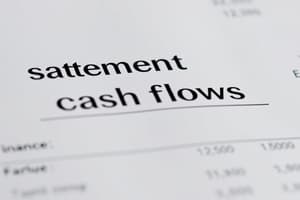Podcast
Questions and Answers
What is the primary benefit of using relevant information in decision-making?
What is the primary benefit of using relevant information in decision-making?
- It increases costs
- It complicates the decision-making process
- It results in better decisions (correct)
- It has no impact on the decision
Accurate accounting information and audited financial statements are not important for businesses.
Accurate accounting information and audited financial statements are not important for businesses.
False (B)
Which section of the statement of cash flows addresses the primary revenue source of providing goods and services?
Which section of the statement of cash flows addresses the primary revenue source of providing goods and services?
- Cash flows from financing activities
- Cash flows from operating activities (correct)
- Cash flows from financial activities
- Cash flows from investing activities
What are the five functions of an information system?
What are the five functions of an information system?
Cash flows from investing activities only include the sale of equipment.
Cash flows from investing activities only include the sale of equipment.
The relationship between buyer behavior and price can be thought of as an __________ that influences marketing strategies.
The relationship between buyer behavior and price can be thought of as an __________ that influences marketing strategies.
What does the statement of cash flows help determine when combined with the beginning cash balance?
What does the statement of cash flows help determine when combined with the beginning cash balance?
Match the following activities with their effects on a business's cash flow:
Match the following activities with their effects on a business's cash flow:
Which statement best summarizes how managers evaluate the financial health of a business?
Which statement best summarizes how managers evaluate the financial health of a business?
The statement of cash flows includes cash flows from operating activities, investing activities, and __________ activities.
The statement of cash flows includes cash flows from operating activities, investing activities, and __________ activities.
Lowering prices always guarantees increased sales figures.
Lowering prices always guarantees increased sales figures.
Match the following sections of the cash flow statement with their descriptions:
Match the following sections of the cash flow statement with their descriptions:
Identify one way information can reduce risk when making a decision.
Identify one way information can reduce risk when making a decision.
Which of the following is NOT included in cash flows from financing activities?
Which of the following is NOT included in cash flows from financing activities?
Comparing a company's current financial results with its own historical data can provide valuable insights.
Comparing a company's current financial results with its own historical data can provide valuable insights.
Why do many businesses include comparisons of financial statements in their annual reports?
Why do many businesses include comparisons of financial statements in their annual reports?
What is the main purpose of an audit?
What is the main purpose of an audit?
Audited financial statements are not important for business decision-making.
Audited financial statements are not important for business decision-making.
What does GAAP stand for?
What does GAAP stand for?
The process of systematically collecting, analyzing, and reporting financial information is known as __________.
The process of systematically collecting, analyzing, and reporting financial information is known as __________.
Match each term with its correct definition:
Match each term with its correct definition:
Which of the following is a benefit of having audited financial statements?
Which of the following is a benefit of having audited financial statements?
Accounting information can only provide insights about the past performance of a business.
Accounting information can only provide insights about the past performance of a business.
What role do public accounting firms play in the auditing process?
What role do public accounting firms play in the auditing process?
What are retained earnings?
What are retained earnings?
The income statement is a summary of a business's assets and liabilities during an accounting period.
The income statement is a summary of a business's assets and liabilities during an accounting period.
What is the formula to calculate net income for a business?
What is the formula to calculate net income for a business?
The difference between income and expenses is referred to as __________.
The difference between income and expenses is referred to as __________.
Match the following terms with their definitions:
Match the following terms with their definitions:
What is the primary purpose of an income statement?
What is the primary purpose of an income statement?
Net sales are calculated before making any adjustments for returns, allowances, and discounts.
Net sales are calculated before making any adjustments for returns, allowances, and discounts.
What are revenues earned by a business from selling goods or providing services called?
What are revenues earned by a business from selling goods or providing services called?
What does the return on sales ratio indicate?
What does the return on sales ratio indicate?
A higher current ratio indicates that a firm can struggle to pay its current liabilities.
A higher current ratio indicates that a firm can struggle to pay its current liabilities.
What is the formula for calculating the current ratio?
What is the formula for calculating the current ratio?
The inventory turnover ratio for Baobab Art Supplies is calculated by dividing the cost of goods sold in one year by the __________.
The inventory turnover ratio for Baobab Art Supplies is calculated by dividing the cost of goods sold in one year by the __________.
What was the return on sales percentage for Baobab Art Supplies?
What was the return on sales percentage for Baobab Art Supplies?
Reducing expenses has no effect on the return on sales.
Reducing expenses has no effect on the return on sales.
What does an inventory turnover of 8.2 times per year mean for Baobab Art Supplies?
What does an inventory turnover of 8.2 times per year mean for Baobab Art Supplies?
Match the following financial ratios with their definitions:
Match the following financial ratios with their definitions:
Flashcards are hidden until you start studying
Study Notes
Statement of Cash Flows
- The Statement of Cash Flows has three sections:
- Cash Flows from Operating Activities: Addresses the business’s primary revenue source - providing goods and services.
- Cash Flows from Investing Activities: Includes the purchase and sale of equipment, land, and other assets and investments.
- Cash Flows from Financing Activities: Reports changes in debt obligations and owners' equity accounts.
- This section includes loans and repayments, the sale and repurchase of the company’s own stock, and cash dividends.
- The totals of all three cash flow sections are added to the beginning cash balance to determine the ending cash balance.
Evaluating Financial Statements
- The balance sheet, the income statement, and the statement of cash flows can provide information about a business’s ability to do business and stay in business, its profitability, and its value as an investment.
- A business's financial health can be evaluated by comparing its current financial data with its own financial results over recent accounting periods and with other businesses in similar industries.
- Companies typically include in their annual reports comparisons of the important elements of their financial statements for recent years.
Information and Risk
- To improve decision-making, the information used by individuals and businesses must be relevant.
- Relevant information leads to better intelligence and knowledge, resulting in better decisions.
- Businesses that have better intelligence and knowledge, which leads to better decisions, may have a competitive edge over competitors and improve their profits.
Information Rules
- Marketing research shows that discounts influence car and truck buyers.
- Lowering prices usually leads to more sales. This relationship between buyer behavior and price is an example of an information rule.
Why Accounting Information Is Important
- Accounting is the process of systematically collecting, analyzing and reporting financial information.
- Accounting information can be used to answer questions about what has happened in the past, and to help make decisions about the future.
- Businesses rely on audits conducted by accountants employed by public accounting firms to improve the accuracy of their accounting information and financial statements.
Why Audited Financial Statements Are Important
- An audit is an examination of a company’s financial statements and the accounting practices that produced them.
- Audits ensure that financial statements are prepared in accordance with generally accepted accounting principles (GAAPs).
- If an accountant determines that a company’s financial statements present financial information fairly and conform to GAAPs, then they will issue an opinion statement, confirming that the financial statements present information fairly.
The Balance Sheet
- The balance sheet shows a company’s assets, liabilities, and owners' equity at a specific point in time.
- Assets are resources owned by a business, such as cash, land, and equipment.
- Liabilities are the obligations that a business owes to others, such as amounts owed to suppliers and banks.
- Owners' equity represents the owners' claims to the assets of the business.
- The balance sheet equation shows the relationship between these three components: Assets = Liabilities + Owners' Equity.
Owners' Equity
- Owners' equity is usually referred to as shareholders' equity for a company.
- The amount reported on the balance sheet is the total value of shares plus retained earnings that have accumulated to date.
- Retained earnings are the portion of a business’s profits not distributed to shareholders.
The Income Statement
- The income statement summarizes a business’s revenues and expenses during a specified accounting period.
- It may be called the earnings statement or the statement of income and expenses.
- The difference between income and expenses defines profit or loss for a business, or cash surplus or cash deficit for an individual.
- The income statement formula is: Revenues – Cost of goods sold – Operating expenses = Net income.
Revenues
- Revenues are the amounts earned by a business from selling goods, providing services, or performing business activities.
- Gross sales are the total amount of all goods and services sold during the accounting period.
- Deductions from gross sales include sales returns, sales allowances, and sales discounts.
- Net sales are the actual amounts received by a business for the goods and services it has sold after adjustments for returns, allowances, and discounts.
Financial Ratios
- A financial ratio shows the relationship between two elements of a business’s financial statements.
Return on Sales (or Profit Margin)
- This ratio measures a business’s ability to earn profits.
- Return on sales is calculated by dividing net income after taxes by net sales.
- A higher return on sales is more favorable.
- A low return on sales can be improved by reducing expenses and increasing sales.
Current Ratio
- This ratio measures a business’s ability to pay its debts.
- The current ratio is computed by dividing current assets by current liabilities.
- A high current ratio indicates that a firm can pay its current liabilities.
- A low current ratio can be improved by repaying current liabilities, reducing dividend payments to stockholders to increase the firm’s cash balance, or obtaining additional cash from investors.
Inventory Turnover
- This ratio measures how well a business manages its inventory.
- Inventory turnover is calculated by dividing the cost of goods sold in one year by the average value of the inventory.
- The average value of the inventory is calculated by dividing the sum of beginning inventory and ending inventory by 2.
- A high inventory turnover indicates that a firm is selling its inventory quickly and efficiently.
Studying That Suits You
Use AI to generate personalized quizzes and flashcards to suit your learning preferences.




